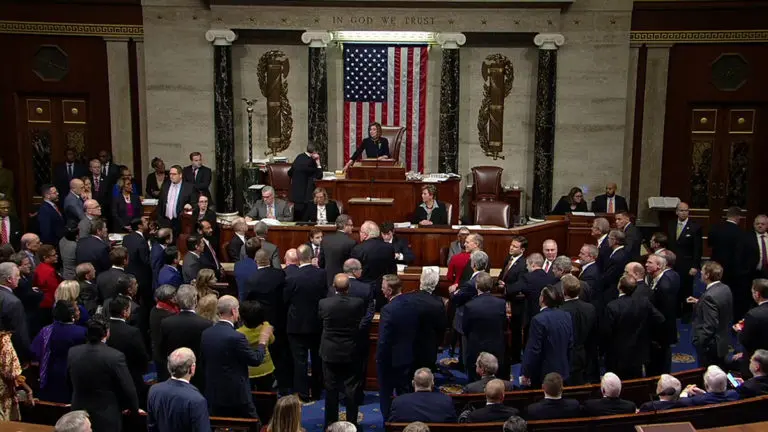On December 17, 2019, the President signed into law two spending packages that cover all twelve annual appropriations bills, funding hundreds of federal agencies, bureaus and initiatives totaling $1.4 trillion for Fiscal Year 2020. Together, the packages include important investment decisions for our kids and several policy provisions benefitting children and avoids a disastrous shutdown like the one in early 2019. The two-bill package (H.R.1158 and H.R.1865) includes a $22 billion increase in defense discretionary spending as well as approximately $25 billion in additional funding for non-defense discretionary programs. The top-line spending numbers for the package adhere to the levels set forth in the Bipartisan Budget Act of 2019 (H.R.3877), which codified the federal budget for the next two years.
The deal boosts funding for key agencies that serve children and families, including the Agriculture, Commerce, Education, Labor, Health and Human Services, Justice, and Housing and Urban Development departments. The funding package also includes several policy changes that are beneficial to children. However, some key priorities were neglected in the deal, especially regarding tax and immigration policies.
Below are some highlights from both bills regarding funding for programs serving children and families as well as some successes and shortcomings for certain policy changes crucial for the well-being of our children:
H.R. 1158 “Consolidated Appropriations Act, 2020”
Division B: Departments of Commerce, Justice, Science, and Related Agencies
Department of Commerce: $73.2 billion in total funding – $9 billion increase from FY19 levels
- $7.6 billion in funding for the Census Bureau, with $7.3 billion of which dedicated to carrying out the 2020 Decennial Census. This level is $1.4 billion above the President’s budget request.
Department of Justice: $32.6 billion in total funding – $1.67 billion increase from FY19 levels
- Juvenile justice programs: Both Title II and Title V received a funding increase. Title V has a significant increase at $42M from $27.5M. This is the first time Title V funding is not entirely earmarked for programs and available for all programs under the Juvenile Justice Reform Act passed at the end of 2018.
- $87.5 million for Missing and Exploited Children, an increase of $5.5 million over FY19 levels.
- $27 million for Victims of Child Abuse, an increase of $4.5 million over FY19 levels
- $97 million for Youth Mentoring, an increase of $2 million over FY19 levels.
H.R. 1865 “Further Consolidated Appropriations Act, 2020”
Division A: Departments of Labor, Health and Human Services, and Education, and Related Agencies
Department of Labor: $12.4 billion in total funding – $291 million increase from FY19 levels
- Employment
and Training Administration —
- $1.74 billion for Job Corps, an increase of $25 million over FY19 levels and $728 million over the President’s budget request. Approximately 39% of Job Corps money is spent on children.
- $913 million for Workforce Innovation and Opportunity Act Youth Training programs, an increase of $9.7 million over FY19 levels
- $94.5 million for YouthBuild Activities, an increase of $5 million over FY19 levels
Department of Health and Human Services: $94.9 billion in total funding – $4.4 billion increase from FY19 levels
- Administration for Children and Families
(ACF) – $24.4 billion, an increase of $1.2 billion over FY19 levels.
- $5.8 billion for the Child Care and Development Block Grant, an increase of $550 million over FY19 levels
- $10.6 billion for Head Start, an increase of $550 million over FY19 levels
- $275 million for Preschool Development Grants, an increase of $25 million over FY19 levels
- Centers
for Disease Control and Prevention (CDC) – $8 billion, an increase of $636 million over
FY19 levels
- $25 million, split evenly between the Centers for Disease Control and Prevention and the National Institutes of Health (NIH), for conducting research on firearm injury and mortality prevention services. This marks the first time in history that these agencies will be able to conduct research on gun violence.
- $37 million for Childhood Lead Poisoning Prevention Program, an increase of $2 million over FY19 levels
- Health Resources and Services Administration
(HRSA) – $7.3 billion, an
increase of $177 million over FY19 levels
- $944 million for programs to improve maternal and child health, including an additional $5 million to reduce maternal mortality. This is a $17 million increase over FY19 levels.
- Substance Abuse and Mental Health Services
Administration (SAMHSA) – $5.9 billion, an increase of $140 million over FY19
levels
- $102 million for Project AWARE, an increase of $33 million over FY19 level.
Department of Education: $72.8 billion in total funding – $1.3 billion increase from FY19 levels
- Programs Serving Students K-12 –
$40.1 billion, a $5.9 billion increase above the President’s budget request.
- $16.3 billion for Title I Grants to Local Educational Agencies, an increase of $417 million over FY19 levels.
- $13.9 billion for Special Education funding, an increase of $417 million over FY19 levels.
- $12.8 billion of this Special Education funding will go to IDEA Part B Grants to States, an increase of $400 million over FY19 levels.
- $20.1 million will fund Special Olympics, an increase of $2.5 million over FY19 levels.
- $1.48 billion for Impact Aid, an increase of $40 million over FY19 levels.
- Three programs slated for elimination under the
President’s budget received funding increases:
- $2.1 billion for Supporting Effective Instruction State Grants, an increase of $400 million over FY19 levels.
- $1.2 billion for Student Support and Academic Enrichment State Grants, an increase of $40 million over FY19 levels.
- $1.2 billion for Nita M. Lowey 21st Century Community Learning Centers (Renamed from 21st Century Community Learning Centers), an increase of $28 million over FY19 levels.
- Other
Education Highlights
- $101.5 million for the McKinney-Vento Act’s Education for Homeless Children and Youth (EHCY) program, an 8.5% increase over the previous year, and a 32% increase over the past four years.
- An overall increase for Higher Education programs, including the Federal TRIO, GEAR UP, Teacher Quality Partnerships, and Child Care Access Means Parents in School programs.
Division B: Agriculture, Rural Development, Food and Drug Administration, and Related Agencies
Department of Agriculture: $23.5 billion in total funding – $183 million increase from FY19 levels
- $6 billion in funding for the Special Supplemental Nutrition Program for Women, Infants, and Children (WIC). This provides full funding for the program based on its projected caseload for the year.
- $90 million for WIC’s Breastfeeding Peer Counselor Program, which is the program’s full authorized amount. This marks the first time that the program has been funded at its authorized level and will enable staffing of peer counselors in every agency across the country.
- $526 million for the Summer Food Service Program, $35 million for the Sumer EBT Program, $30 million for School Kitchen Equipment Grants, and $5 million for school breakfast expansion grants. All of these programs ensure low-income students continue to receive nutritious meals both when in school and during breaks.
Division H: Transportation, Housing and Urban Development, and Related Agencies
Department of Housing and Urban Development: $49.1 billion – $4.9 increase from FY19 levels
- $290 million for the Lead Hazard Reduction Program, an increase of $11 million over FY19 levels.
- $175 million for Choice Neighborhoods, an increase of $25 million over FY19 levels.
- $2.78 billion for Homeless Assistance Grants, an increase of $140 million over FY19 levels.
Policy Provisions Benefitting Kids and Some Unfinished Business
Along with funding the government, the spending package also contained a number of extensions for expiring tax and health provisions as well as other policies. While we are pleased that some of these provisions were able to pass as part of the package, some stopped short of their full potential to help children and some key provisions were left off entirely.
Health Extenders:
- Extends the Community Mental Health Services demonstration program
- Extends Medicaid funding for U.S. Territories for 2 years
- Delays Medicaid payment cuts to Disproportionate Care Hospital (DSH) for 5 months
- Extends Community Health Centers, the National Health Services Corps, and Teaching Health Centers
First Focus on Children supports the language in the bills that eliminates the pending Medicaid funding cliff to the territories caused by Medicaid block grants. However, the legislation limits Medicaid relief for Puerto Rico and the other territories to a mere two years and fails to adopt a more generous bipartisan proposal. This failure to protect American citizens in the territories highlights the vast inequalities, rationing of care, and financing problems caused by Medicaid block grants.
Tax Provisions:
- Repeals the “Cadillac Tax,” an Affordable Care Act (ACA) tax on the most generous health insurance plans intended to limit the growth of private-sector health care costs, but was crafted in a way that would have incentivized employers to increase out-of-pocket expenses for family and dependent health coverage, particularly for families with children.
- Repeals the “Kiddie Tax,” a provision of the 2017 Tax Cuts and Jobs Act (TCJA) that created a tax on children’s unearned income. The provision had the unintended consequence of raising taxes on income such as survivor benefits received by the children of fallen military members and first responders.
One major shortcoming of the spending package is that it leaves out an expansion of refundable tax provisions, such as the Child Tax Credit (CTC) and the Earned Income Tax Credit (EITC). These provisions aim at helping low-income children and families make ends meet and have a successful track record for lifting children and struggling families out of poverty. This package neglects to act on recent bipartisan proposals to expand these credits, which is a crucial missed opportunity for lifting millions of children out of poverty.
Other Policy Riders That Impact Kids:
- Increases the legal purchasing age of Tobacco from 18 to 21
- Temporarily reauthorizes Temporary Assistance for Needy Families (TANF) for 5 months until May 5, 2020. This short-term extension provides an opportunity to realize the substantive reforms and additional funding that is needed to make TANF more effective at reducing child poverty. This includes clarifying that an explicit purpose of TANF is to reduce child poverty.
- Adopts the Family First Transition Act to help states successfully implement the Family First Prevention Services Act that aims to prevent children from entering foster care by allowing federal reimbursement for mental health services, substance use treatment and in-home parenting skill training, along with other initiatives to improve the well-being of children already in foster care.
Unfortunately, the legislation does not include an agreement to extend the Maternal, Infant, and Early Childhood Home Visiting Program (MIECHV) with a doubling of the funding for four years. The legislative package also does little to address grave and widespread concerns for the treatment of children at the border, and, in fact, continues funding for DHS’s outrageous “Migrant Protection Protocol” program that continues to cause harm to tens of thousands of vulnerable children and families every day. Furthermore, the funding package fails to restrict the administration’s practice of transferring funds to pay for the southern border wall or more immigrant detention, therefore putting at risk essential resources that may benefit our nation’s children.


